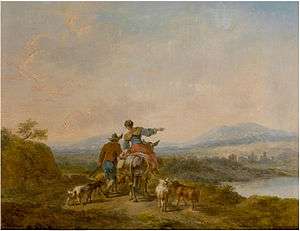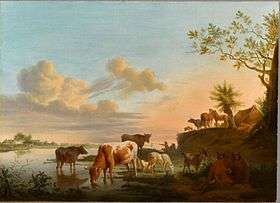Balthasar Paul Ommeganck

Balthasar Paul Ommeganck (sometimes also: Paul Balthasar Ommeganck) (1755–1826) was a Flemish painter of landscapes and animals. Through his work and his role as a teacher he gave an important impetus to the revitalization of landscape painting in the Low Countries.[1]
Life
He was born in Antwerp in 1755 as the fourth child of Paulus Ommeganck and Barbara Laenen. He was registered in the Antwerp Guild of Saint Luke as a pupil of the respected painter Hendricus Josephus Antonissen from 1767. At the same time he also attended classes at the Antwerp Academy where he obtained a second prize for drawing after the Antique in March 1771. He specialized in landscapes and the rendering of the coat of animals in particular of sheep.[2]

On 26 June 1781 he married Petronilla Isabella Maria Jacoba Parrin in Antwerp. They had two sons and seven daughters, one of which was the animal painter Johanna Maria Ommeganck.[2][3]
He was one of the founders in 1788 of a society of artists known as the Genootschap ter aanmoediging der Schoone Kunsten ("Society for the encouragement of the fine arts'), known under its short form as the Konstmaatschappij (the 'Art Society'). Other founders included Hendrik Frans de Cort, Pieter Faes, Miss Herry, Jan Josef Horemans the Younger, Ferdinand Verhoeven, Hendrik Aarnout Myin, Frans Balthasar Solvyns, Mattheus Ignatius van Bree, Maria Jacoba Ommeganck, Marten Waefelaerts and many others. The society's goal was to provide opportunities for the promotion and appreciation of the artworks of its various members in an informal setting. The first exhibition of the society was held in Antwerp in 1789. Ommeganck contributed 4 works to this first exhibition.[2][4]
In 1789 he became dean of the Guild of St. Luke of Antwerp, the penultimate dean as the Guild was dissolved by the French occupiers in 1794. In 1796 he was appointed professor at the Antwerp Académie de peinture, sculpture et architecture d'Anvers.[2]

In 1799 a painting of Ommeganck won the first prize for landscapes in Paris. Ommeganck had not wished to participate in the Paris competition but the painting was submitted by a friend without his knowledge. In 1809 he became a corresponding member of the Institut de France, which had been established on 25 October 1795 to group France's five académies. He was also a member of the Academies of Amsterdam, Brussels, Ghent, Munich, and Vienna.[2]
He was one of the commissioners who were appointed by the Dutch government in 1815 to recover from France the objects of art which France had stolen during the occupation.[1][2]
His students included Jan Baptiste de Jonghe, Frédéric Théodore Faber, Pieter Martinus Gregoor, Jacob van Kouwenhoven, Hendrik Aarnout Myin, Ignatius Josephus van Regemorter, Adrianus de Visser, Eugène Joseph Verboeckhoven, Julien-Joseph Ducorron and his sister Maria Jacoba Ommeganck.[1][3]
He died in Antwerp.
Work

Ommeganck was very successful during his lifetime and his works demanded high prices.[2] His main contribution to landscape painting was the combination in his works of the light found in the work of the Dutch Italianate painters of the 17th century with detailed observation of nature. He was thus able to find a synthesis between realism and an idealized representation of nature. His work shows a painstaking attention to detail, a sure line and subtle use of colour. His preferred subjects were undulating landscapes. He painted mainly on panel.
Ommeganck's style was widely followed in the 18th and early 19th century.[1] Later art critics have not always been equally positive about the work of Ommeganck. Some have made the reproach that by embedding itself in the classic tradition and through its preference for the contrived, picturesque and the conventional, the landscape tradition of Ommeganck represents a 'hopeless traditionalism'.[5]
He also made a few portraits such as that of the Painter Jan Baptist Berré (Royal Museum of Fine Arts Antwerp).
He was a skilled draughtsman and also worked as a sculptor producing some clay models of sheep and cows.
References
- 1 2 3 4 Dominique Vautier. "Ommeganck, Balthasar-Paul." Grove Art Online. Oxford Art Online. Oxford University Press. Web. 4 Dec. 2014
- 1 2 3 4 5 6 7 Catalogue du Musée d'Anvers, Second Edition, 1857, p. 463-469 (French)
- 1 2 Balthasar Paul Ommeganck at the Netherlands Institute for Art History (Dutch)
- ↑ Reginald Howard Wilenski, Flemish Painters: 1430-1830, Viking Press, 1960, p. 418
- ↑ Lut Pil, Pour le plaisir des yeux: het pittoreske landschap in de Belgische kunst : 19de-eeuwse retoriek en beeldvorming, Garant, 1 Jan 1993, p.1-2 (Dutch)
External links
![]() Media related to Balthasar Paul Ommeganck at Wikimedia Commons
Media related to Balthasar Paul Ommeganck at Wikimedia Commons